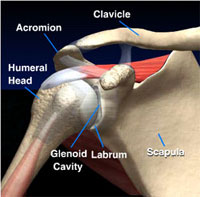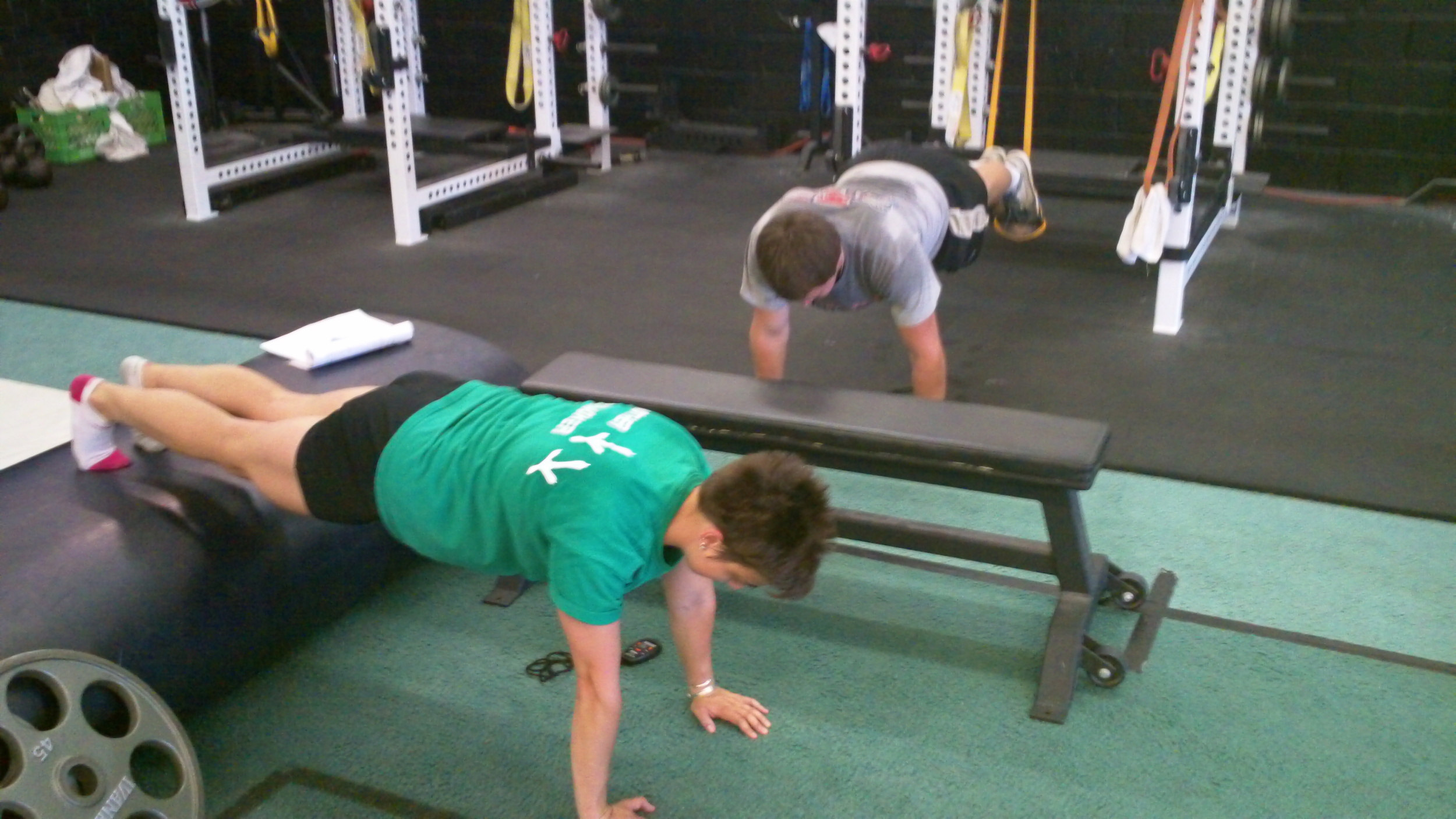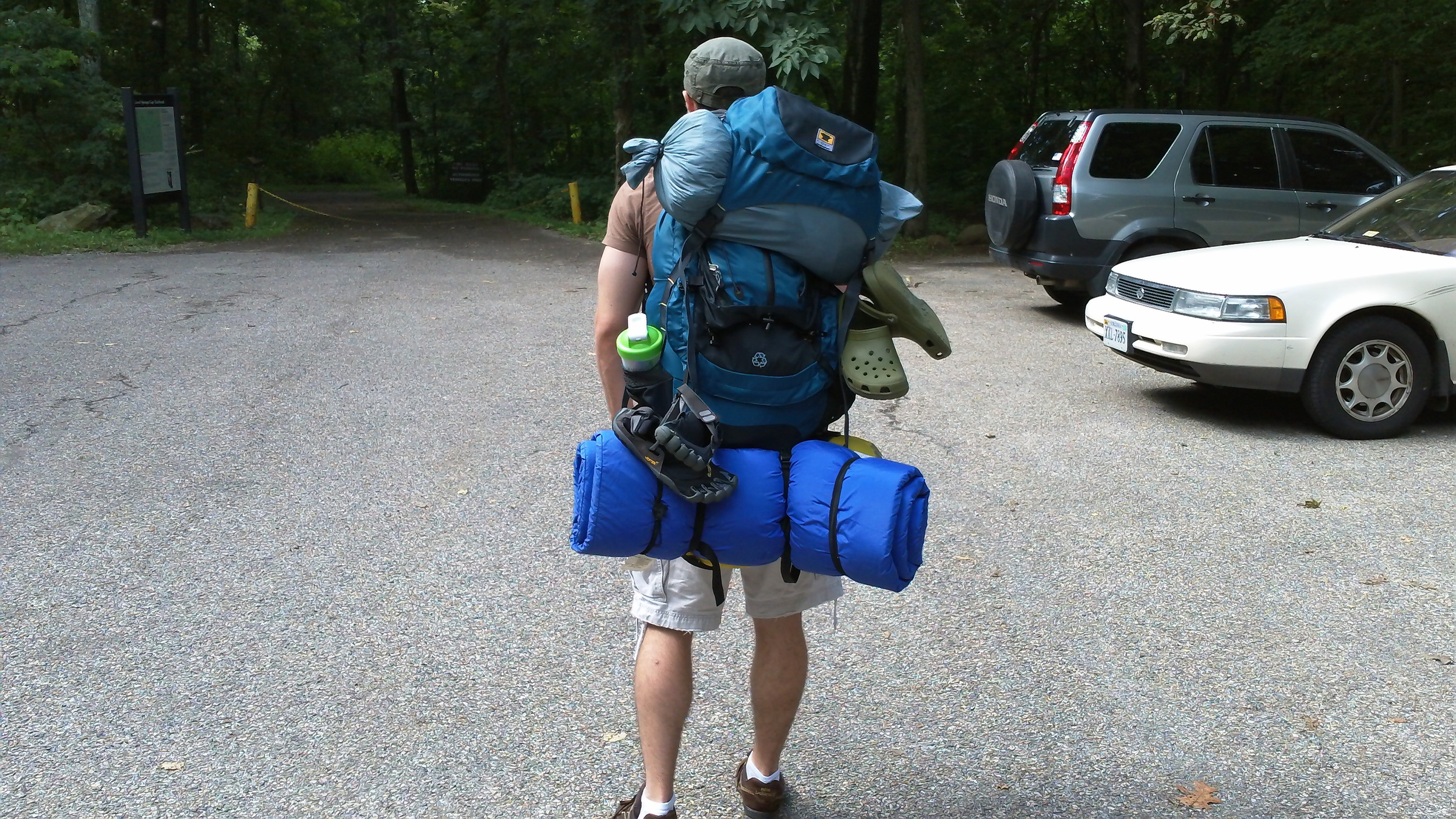Suitcase Carry: An Exercise I like (and you should, too).
This past weekend I decided, spur-of-the-moment, to take a backpacking trip with a couple good friends of mine. It was incredible, to put it mildly. We loaded up our packs and took them for a 2-day journey along the Appalachian Trail in the Shenandoah. As evening approached, we found a great place near an overlook to pitch our tents. The picture at the top is a photo I snapped of our view of the sunset. As I was hiking along, I was quickly made aware that walking for two days - over uneven terrain with a 40lb pack on your back - makes for a pretty awesome workout. My traps, glutes, hamstrings, and cardiovascular system were all telling me that, just because I was away from the gym for a weekend, didn't mean I was going to get away with time off. To left is a picture snapped just before the start of the journey.
However, the point of this blog post isn't to tell you about my hike, the bears I slayed with my bare hands (they made the first move and attacked first, ok), or the damsels in distress I rescued along the trail. The point of this post is to give you a phenomenal exercise you can do in just about any gym. It isn't anything new, but my hike over the weekend reminded me just how much I love carry variations (due to the pack I carried throughout the trip), and how great they are for you.
The Exercise
Enter the Suitcase Carry. This will hammer your core (emphasis on the obliques and quadratus lumborum), along with your traps, deltoids, forearms, and ankles. Yes, the ankles.
It's tough to truly appreciate this exercise until you try it. See the video below of Ron performing the exercise:
How to Do It
You won't reap or feel the benefits of this exercise unless you walk with as perfect posture as you can. The key is to stand TALL. Your hips are going to naturally drift toward the weight, so do as best as you can to keep the hips from shifting. Shoulders "back and down," and stick your chest out as if your flaunting your stuff at the beach.
Why I Like It
One of the reasons I like this exercise so much is that most of you can do it in nearly any gym, and it kills multiple birds with one stone (see the benefits listed above the video). Just grab a heavy dumbbell, stand straight, and walk for 50-100 yards. Then switch sides. Even if you only have ten yards of space to work with, you can walk back and forth until you reach your target distance. You can use a heavy dumbbell or kettlebell for this. Yes, in the video, Ron has two kettlebells tied together with a towel because we're cool like that.
How much weight or how far should you go? As Dan John put it: You can either carry light weight for long distances, or heavy weight for short distances. I prefer heavy weight for long distances.
We've been doing this exercise for a few years but primarily using a "towel grip," during which you hold a towel looped through the kettlebell. While this is a perfectly good variation, I like tossing in the towel-free version as it takes a bit of stress off the grip (thus your grip will no longer be the limiting factor) and places more of the tension throughout the other areas of the body.
You know when you see people in the airport nearly toppling over to the side because their suitcase is so heavy? It's primarily because their core can't effectively buttress the weaker joints throughout the body. Don't be that guy.
Bird-Dogs, Verticals, etc.
I'm not gonna lie, I'm experiencing some major writer's block this morning, so it's going to be short and sweet today.
1. I thought I'd share an exercise I've been using for some active recovery circuits, and as a filler exercise in some of our overhead athlete's programs. It's a sandbag walkup with a pushup position bird-dog at the top.
While this exercise may seem a bit "frou-frou" at first glance, don't knock it till you try it. In fact, most will need to start by lifting the arm only, as adding the alternate leg lift will cause many people to topple over.
Why I like it
- The hand-walking portion helps to promote scapular stability (via strengthening of the serratus).
- The alternate arm+leg lift gives you some pretty solid benefits in the trunk stability department, as your entire body will have to resist rotation (in the transverse plane) and hyperextension of the low back (in the sagittal plane).
- You can perform it nearly anywhere. Whether you're traveling, at home, in the gym, etc. all you need is something (a phone book, aerobics step, etc.) to elevate your hands on.
How to do it
- Don't fall over.
- The main thing you need to watch out for is hyperextension (excessive arching) of the low back and you lift up the opposite arm and leg.
- Hold each reach for a two-count.
- Perform for 6-10 repetitions.
When it comes to taking an off day, you either have people doing nothing, or you get those that consider 400m repeats and/or long distance running an off day. Both are sub-optimal and will most likely hinder your recovery process.
Toss in this walkup variation along with some mobility drills, crawl variations, bodyweight split squats, KB swings, etc. and you'll have yourself accelerating blood flow to damaged tissue, ungluing sticky joints, charging yourself for the following day's training session, and enjoying the sensation of undoing the musculoskeletal nightmare of sitting at a desk for 8 hours straight.
2. We just re-tested the vertical of Alexis (who plays for one of VA's premiere volleyball teams), after 16-weeks of training with us.
Long story short, her vertical jump improved 9 inches over the last 16-weeks. And yes, we're measuring absolute vertical displacement, not simply how far up she can touch (as she's grown 1/2" over the past four months, which we took into account). A huge congrats to Alexis for all her hard work!
How did we accomplish this? Simple. Lots and lots and lots, and lots, of jumping, "plyometrics," and endless agility drills. The more of these, the better. (Go back those two sentences again again, but with a healthy dose of sarcasm).
The reality is we rarely used more than 15 TOTAL jumps in a given session (and she only trained twice a week).
Increase the horsepower, the brakes, and the accelerator. Therein lies the key. Furthermore, most trainees can benefit tremendously from developing eccentric force absorption and muscle contraction (one example of this would be altitude drops....using the appropriate progressions), which will lay the framework for enhanced concentric strength potential. Then, Voila! We have more reactive and stronger athletes capable of greater force and power output.
4-Weeks to a Stronger Total Body
That’s a short amount of time to make some big gains, I’ll admit. But for much of the population adding a grip strength specialization routine to their regular training program can result in significant gains on all of their lifts. Why is improving grip strength so effective? Basically, grip strength tends to be the “weak link” for recreational lifters and athletes alike and, thus, a lot of extra neural activity is wasted in the direction of controlling the grip musculature that can be more effectively directed towards the large muscle groups (think about the deadlift… what fatigues first? Your legs, your back, or your grip? The last thing you should notice fatiguing is your grip). So, spend a handful of weeks crushing your grip and you should quickly notice the following benefits:
1. For most men, another 3-5 reps squeezed out on pulling movements like body weight pull-ups and for most women, another 1-2 reps. 2. The perception of easier deadlifting and – gasp – even squatting! You heard it hear first, folks, a stronger grip will give you a bigger squat, too! 3. A slight bench press PR… it might show up in the form of a repetition PR or a max PR, I’m not sure. But you’ll get a PR, I promise. Want to test this one out? Set up a bench press with just the bar, for the first 5 repetitions lightly grasp the bar and notice how it feels. Then reset and this time squeeze the bar as if your life depends on it. What do you notice now? Something you already though was easy is now way easier and those nagging issues with shoulders and wrists often clear up like magic.
You’ll even get injury prevention benefits for the elbow and shoulder directly from increased and focused grip training. Plus, if you want to include the numerous injury prevention benefits that will come from increasing load and proficiency on the lifts I noted above, you only have to ask yourself… “How fast can I get some heavy fat bar holds going on?!?”
 At SAPT, grip training is a regular portion of our programs and can be found in forms both direct and indirect. Here are a few examples of some of our favorite direct grip exercises:
At SAPT, grip training is a regular portion of our programs and can be found in forms both direct and indirect. Here are a few examples of some of our favorite direct grip exercises:
• Farmer’s Walk variations with a towel hold. • Kettlebell or plate pinch (squeeze as if you’re trying to ring water from the iron). • Sledge Leveraging. • Sledge Finger Walks (not for the faint of heart). • Barbell Holds – one of my personal favorites for the rowing team at Mason – just load up a barbell and hold with perfect posture for time.
Consider spicing up your routine and your fast tracking your strength gains by adding in some direct grip work – and for goodness sake, if you know what “straps” are, throw them away!
Suspended Pushup (with a twist) for an Added Challenge + Improved Shoulder Stability
 The primary function of the rotator cuff (which many people often miss) is to center the humeral head in the glenoid fossa. In order to accomplish this, the dynamic stabilizers of the shoulder need to be on their "A" game. This is of special consideration when dealing with athletes, as the nature of competition is frequently an "open loop" scenario.
See the video below for a pushup variation that incorporates some dynamic stabilization of the shoulder girdle. We named it "Suspended Pushup ISO Hold (with perturbations) into Repetitions."
The primary function of the rotator cuff (which many people often miss) is to center the humeral head in the glenoid fossa. In order to accomplish this, the dynamic stabilizers of the shoulder need to be on their "A" game. This is of special consideration when dealing with athletes, as the nature of competition is frequently an "open loop" scenario.
See the video below for a pushup variation that incorporates some dynamic stabilization of the shoulder girdle. We named it "Suspended Pushup ISO Hold (with perturbations) into Repetitions."
A couple notes:
- Having a studly powerlifter give you perturbations during the ISO hold is optional, as the suspension straps inherently provide a stability challenge on their own.
- This exercise hits multiple birds with one stone. It will give you a tremendous challenge for your core (you're essentially holding a plank position for the entire time), give you a nice stretch for the pecs in the bottom, improve the ability of your rotator cuff to stabilize the humeral head (where your upper arm bone attaches to the shoulder joint), and develop your upper body strength. Sounds like a winner to me.
- As shown in the video, hold at the bottom for 10-20 seconds, and then move into the desired number of repetitions. Stay TIGHT in the bottom. Everything should be braced. Everything....
- Using the suspension straps is actually a fairly advanced progression of a pushup (especially if your feet are elevated, as shown). Be sure you master the ground-based pushups first.
- (Piggybacking off of #2) If you don't have access to suspension straps (or a partner), no problem! Holding a tight isometric at the bottom of a pushup (on the floor), and then moving into repetitions, can make a great way of taking on a new challenge if standard pushups have become a bit easy for you.
- You increase testosterone levels by 50% if you wear a "Do Work" shirt while performing these.
Just don't tear your shoulder in two....Stevo
PUPP: The Most Simple (Yet Difficult) Exercise You're Not Doing
Want a surefire yet simple method of making your current workout more challenging, while simultaneously improving your core stability and shoulder endurance? Instead of walking around (or checking your cell phone) during your rest period, get into the top of a pushup position, and hold it right there while keeping your body stiff as a board. Do this for 30 seconds, and then return to your next exercise. Dan John calls this a “PUPP” (Push-Up Position Plank).
Give it a shot for a few rounds. You'll quickly begin to feel your abdominals, chest, and shoulders burning like crazy.
A few months ago I put together a video of enough anti-extension core exercises to last you a lifetime:
However, most people (and I'm no exception), could really just use PUPP for a loooongg time and continue to garner the benefits from it. After a while, you can elevate the feet, place your feet in suspension straps, or place a weight on your back. The progressions are nearly endless, and believe me when I say you don't need to progress too quickly.
 Above is a picture of Kelsey and Carson both performing a PUPP. Kelsey is using the method I described above, and Carson is doing it as an actual exercise in his training program, holding it for 60 seconds (when you have your feet in TRX straps, you won’t want to do it more than a few times).
Above is a picture of Kelsey and Carson both performing a PUPP. Kelsey is using the method I described above, and Carson is doing it as an actual exercise in his training program, holding it for 60 seconds (when you have your feet in TRX straps, you won’t want to do it more than a few times).
Note that this exercise is only as challenging as you make it. Sure, most people can hold themselves up for a minute. But few can do it correctly, and thus reap the full benefit of it. Your glutes should be squeezed so tight that a walnut would be cracked between them. Your stomach should be maximally braced to the point that if I were to suddenly punch you in the gut, you wouldn’t feel it. No sagging of the low back, and you should be able to draw a perfectly straight line from the top of your head through your heels (no reaching forward, or looking up, with the head).
Try it. That shaking throughout your torso occurring at the halfway point is your body telling you that you’re not too advanced for planks.
Other Applications Moving along a similar thread, I’ve found that the PUPP also makes an excellent exercise for those struggling to either:
a. Do their first perfect pushup b. Improve their max number of bodyweight pushups (ex. as in a military challenge)
A lot of people go up in smoke when they attempt the pushup because their core musculature fails in its role as a stabilizer, as opposed to the primary movers (ex. chest, shoulders, and and triceps) failing. By the way, by “core” I’m referring to the 30+ muscles that attach to your pelvis, not just your abs! All of these muscles must learn to work as a unit, and the pushup position hold aids you in your quest to achieve this.
So get to work, and enjoy some newfound stability and strength-endurance in your upper body and lumbopelvic regions.
-Stevo
SAPT's Top 5 Exercises for New Moms
I’ve always heard a lot about how hard it is for a new mom to find time to exercise. But, I’m now living it and I’m here to tell you it’s a bunch of hooey. Regardless of time, here are my top 5 best exercises that ALL new moms are already doing in some form or fashion. So why not make them an actual workout?… you’re doing them anyway!
My Top 5 Exercises for New Moms
- Baby Goblet Squat (Ass to Grass) - I can’t even begin to guess the number of deep squats I’ve done over the last 12 months. This is a legit exercise that allows mom to work on ankle, hip, and thoracic mobility along with quad, hamstring, glute, CORE musculature, and upper back strengthening. Start with just a couple sets of 3-5 reps and work up 10, 15, or even more reps.
- Stairs – This one’s easy and obvious. That sweet little baby wants to be held all the time and mom wants to finish losing those last few LB’s, so why not take advantage of the situation and do a little low impact cardio on your household’s stair case?
- Baby Clean and Press – This one is fun for mom and baby and, as is common for all these exercises, occurs naturally. Hold the baby about mid-torso level and hoist her up overhead. This will work on a touch of posterior chain power development and get mom some much needed upper body strength and stability! Stick with just a handful of reps (3-6) for multiple sets.
- Baby Gate Hip Mobility – If the Ass to Grass Baby Goblet Squats aren’t getting it done for the hip mobility, then inevitably mom will have the benefit of crossing over a baby gate about 3 zillion times a day. I started enjoying improved hip mobility around 7 months when Arabella began crawling and suffered two cracked toenails to prove my hip mobility could, in fact, use improvement. You can’t do to many of these, just try to keep good form (chest up, lift you knee, no hip drop) and enjoy the benefits!
- Baby Carrier Household Chores – Talk about great for improving general physical preparedness (GPP)! Last summer Arabella and I spent many hours together with her strapped on my chest in the baby carrier while I did everything from dishes to laundry to vacuuming. You quickly learn if your core is strong or not. This one crushes the lower and upper back, in particular, but is excellent for rebuilding stabilization strength in mom’s midsection.
Here are a few more advanced exercises you can give a try if you’re feeling “froggy.” I should note that my baby is not old enough to reliably stay on my back for the plank or push-ups, maybe in a few more months!
- 1-Arm Baby Cradle Carry + Full Laundry Basket Carry – An advanced technique for the busy mom. Grab baby in one arm and full laundry basket in the opposite arm. This exercise is very similar to some of the Mis-loaded bracing/farmer’s walk variations we do at SAPT. Great for improving core strength and stability!
- Baby Plank – Use baby’s body weight to increase the difficulty of a standard prone plank.
- Baby Pushups – Again, using baby’s body weight to increase the difficulty of a push-up. Although we haven’t tried these yet, I’m pretty sure she’ll be having a pretty good time sitting on my back while “the ride” takes her up and down!
I’ll admit when I got the idea for this post it was designed to be “tongue in cheek,” but as I got to thinking about all the ways having a baby challenges new moms physically, I realized that these are some pretty darn good exercises. Not only are they fun, but they are also very productive if you just focus on doing a few things correctly and accumulating a bit of volume.
So to sum up, today is Arabella’s first birthday and I find myself exceptionally happy. I’m completely in love with my daughter and have found that my husband and I truly work well together. I’ve managed to lose all my “baby weight” and even a few more pounds to boot. And the icing on the cake? I’m working less and earning more.
If you know any new moms who might find this post motivational or inspirational, please forward it to them and don’t forget we offer comprehensive distance coaching to help moms all over the country lose those last few baby LB’s!









